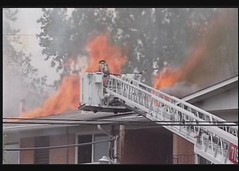Note: the below is from a blog written by Pam Boe who is a volunteer Paramedic and is married to one of our career Fire Captains. This provides you a glimpse into other aspects of public safety life - continuing education and re certification training. The learning and training never stop! Our folks are always working hard to be prepared and ready to respond to all sorts of emergencies here in the county.
And some of our folks work hard to become, and maintain, certifications as instructors going that extra mile! They not only teach a curriculum but they also pass along invaluable real world experiences that may help save a life one day!
Thanks to Pam and her blog,
Mama Boe, for allowing us to "reprint" this here.
-Bill D
It takes an innate ability to read an audience to be a decent classroom instructor. Especially when your students are:
1) Adults,
2) Very Bright,
3) In your class mandatorily to maintain their certification, and,
4) Medics.

I don’t know that I would have the courage to lecture such a roughened, seasoned, bunch of extreme, living-on-the-edge-for-a-career kind of people.


(Heck I’m amazed
I have the courage to show up at all, even just to
sit in the back.)
But these guys do:

Joe, Adam, and Ty….Decades of experience between them. Hundreds of lives saved or healed for the better because of them, personally. Thousands of lives affected positively because of the medics they teach and train.
To be able to teach a subject is to have mastered it. To be able to teach it in a way that keeps the student not only interested, but also entertained, is a talent.
In this particular case, everybody wins. The teachers, for the mastery… the students, to grow their skills and knowledge… and the citizens they serve, for they will get better care for it.
Most people don’t realize how much work goes into and behind each and every 911 call that goes out. It’s not as simple as getting into an ambulance and picking the patient or victim up. Hours and hours of training go into it.
Why?
Because the medics want to do a good job?
Because the medics don’t want to be caught with their pants down?
Because the medics are afraid of litigation?
Because the medics have some kind of ‘Hero’ or ‘God’ complex?
No.
It’s simply because they care.
 According to the National Hurricane Center, every year an average of 11 tropical storms develop over the Atlantic Ocean, Caribbean Sea and Gulf of Mexico. Many of these remain over the ocean and never impact the U.S. coastline. Six of these storms become hurricanes each year. In an average 3-year period, roughly five hurricanes strike the U.S. coastline, killing approximately 50 to 100 people anywhere from Texas to Maine. Of these, two are typically "major" or "intense" hurricanes (a category 3 or higher storm on theSaffir-Simpson Hurricane Scale). By knowing your vulnerability and what actions you should take, you can reduce the effects of a hurricane disaster. Learn more...
According to the National Hurricane Center, every year an average of 11 tropical storms develop over the Atlantic Ocean, Caribbean Sea and Gulf of Mexico. Many of these remain over the ocean and never impact the U.S. coastline. Six of these storms become hurricanes each year. In an average 3-year period, roughly five hurricanes strike the U.S. coastline, killing approximately 50 to 100 people anywhere from Texas to Maine. Of these, two are typically "major" or "intense" hurricanes (a category 3 or higher storm on theSaffir-Simpson Hurricane Scale). By knowing your vulnerability and what actions you should take, you can reduce the effects of a hurricane disaster. Learn more...



































